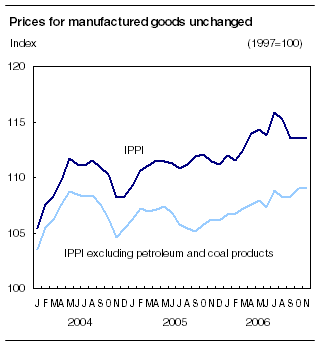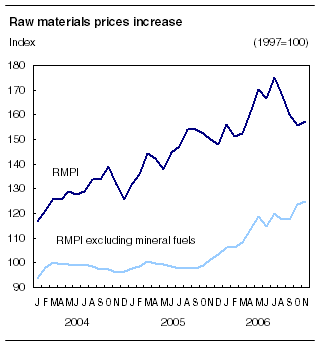Common menu bar links
Industrial product and raw materials price indexes
Archived Content
Information identified as archived is provided for reference, research or recordkeeping purposes. It is not subject to the Government of Canada Web Standards and has not been altered or updated since it was archived. Please "contact us" to request a format other than those available.

Prices for manufactured goods remained unchanged for a second consecutive month in November, while prices for raw materials increased after three months of significant declines.

Prices charged by manufacturers, as measured by the Industrial Product Price Index (IPPI), were unchanged from October to November, as downward pressure from declining petroleum prices eased. Lower prices for primary metal products and petroleum products were offset by higher prices for chemical products, fruit, vegetables and feed products and pulp and paper products.
Note to readersThe Industrial Product Price Index (IPPI) reflects the prices that producers in Canada receive as the goods leave the plant gate. It does not reflect what the consumer pays. Unlike the Consumer Price Index, the IPPI excludes indirect taxes and all the costs that occur between the time a good leaves the plant and the time the final user takes possession of it, including the transportation, wholesale, and retail costs. Canadian producers export many goods. They often quote their prices in foreign currencies, particularly for motor vehicles, pulp, paper, and wood products. Therefore, a rise or fall in the value of the Canadian dollar against its US counterpart affects the IPPI. The Raw Materials Price Index (RMPI) reflects the prices paid by Canadian manufacturers for key raw materials. Many of these prices are set in a world market. Unlike the IPPI, the RMPI includes goods not produced in Canada. |
The 12-month change in the IPPI was up 1.9%, a higher rate of growth compared to the year-over-year increase of 1.2% in October. Upward pressure came mainly from higher prices for primary metal products, pulp and paper products as well as fruit, vegetable and feed products.
The Raw Materials Price Index (RMPI) was up 0.9% from October to November, following three months of declines. The increase was due to higher costs for mineral fuels, non-ferrous metals as well as vegetable products.
Compared to November of last year, raw materials cost factories 4.6% more, a significant change from the year-over-year increase of 2.2% in October.
The IPPI stood at 113.5 (1997=100) in November, unchanged from a revised level of 113.5 in October. The RMPI reached 157.1 (1997=100), up from a revised level of 155.7 in October.
IPPI: Prices remain unchanged
On a month-over-month basis, manufacturers' prices were unchanged, as downward pressure from declining petroleum prices eased. The decrease in prices for primary metal and petroleum products was offset by higher prices for chemical products, fruit, vegetable and feed products as well as pulp and paper products.
Prices for primary metal products fell 1.4% in November, following an increase of 3.8% in October. Prices for copper and copper alloy products were down by 10.3% while prices for nickel products declined by 9.6%, due to a slowdown in construction activity, lower demand and higher inventories. On the other hand, prices for aluminum products (+3.1%) rose for a second month in a row, due to lower supply.
Petroleum and coal products prices fell 0.3%, the lowest monthly decrease in the past four months. If petroleum and coal product prices had been excluded, the IPPI would still have remained unchanged from October.

However, there were some monthly increases. Prices for chemical products rose 0.9% as a result of higher prices for organic industrial chemicals. Higher prices were also observed for fruit, vegetables and feed products (+1.0%) as well as pulp and paper products (+0.5%).
IPPI: Primary metal products continue to be the major contributors to the 12-month change
The IPPI was up 1.9% in November compared with the same month a year earlier, an increase in the rate of growth compared to the previous two months. The higher rate of growth is mainly the result of the slowdown in the year-over-year decrease of petroleum products. If petroleum and coal product prices had been excluded, the IPPI would have increased 2.6%.
Prices for primary metal products were up 26.4% compared to November 2005. Prices for nickel products (+125.7%), copper products (+46.0%), refined zinc products (+143.6%) and aluminum products (+16.3%) were all higher compared with one year earlier.
Higher prices for pulp and paper products, fruit, vegetable and feed products, non-metallic mineral products, metal fabricated products, and tobacco products also contributed to the annual increase.
The annual rate of growth in the IPPI was dampened by lower prices for petroleum and coal products (-5.4%), as well as lower prices for motor vehicles and other transport equipment (-2.6%), lumber and other wood products (-5.5%) and chemicals and chemical products (-2.9%).
RMPI: Crude oil prices are up
Raw materials prices rose 0.9% in November, following three months of significant decreases.
Mineral fuels were the major contributor to this monthly increase with prices rising 0.8% compared to October. Prices for crude oil were up 0.8%, mainly as a result of the decision by oil producing countries to cut production. Crude oil prices remained 26.4% lower compared to the peak in prices registered in July 2006. If mineral fuels had been excluded, the RMPI would have risen 1.1% from October instead of 0.9%.
Non-ferrous metals prices were up 1.8% as prices for zinc, radio-active concentrates, gold and silver increased due to strong demand.
Prices for vegetable products rose 5.6% from the previous month, as prices for barley, corn, wheat, canola and soybeans increased. This was mainly the result of tight supply as well as strong demand.
Prices for animal and animal products decreased 1.1% as a result of lower prices for fish as well as cattle and hogs for slaughter.
On a 12-month basis, the price of raw materials rose 4.6% in November, a higher rate of growth compared to the 2.2% year-over-year increase in October. This rate of growth remains moderate compared to the annual change registered in the first three quarters of the year. If mineral fuels had been excluded, the RMPI would have increased 23.2% instead of rising 4.6%.
Non-ferrous metals were the major contributors to the 12-month increase with prices rising 73.6%, mainly the result of year-over-year price increases for zinc, radio-active concentrates, copper, nickel and lead.
Prices were also higher than one year ago for wood, vegetable products as well as non-metallic minerals.
Mineral fuels were down 11.2% with crude oil prices falling 11.0%. This was the third negative year-over-year change in a row. Prices for animals and animal products and ferrous materials were also down from a year ago.
Impact of the exchange rate
The value of the Canadian dollar against the US dollar was down 0.7% between October and November. As a result, the total IPPI excluding the effect of the exchange would have fallen 0.2% instead of remaining unchanged.
On a 12-month basis, the value of the Canadian dollar rose 3.9% against the US dollar. If the impact of the exchange rate had been excluded, producer prices would have risen 3.0% between November 2005 and November 2006, rather than their actual increase of 1.9%.
Prices for intermediate goods are unchanged
Prices for intermediate goods remained unchanged from October. Higher prices for chemical products, fruit, vegetable and feed products, pulp and paper products and motor vehicles were offset by lower prices for primary metal products as well as petroleum products.
Producers of intermediate goods received 3.5% more for their goods in November 2006 than in November 2005. Higher prices were registered for primary metal products, pulp and paper products, fruit, vegetables and feed products, metal fabricated products, non-metallic mineral products, electrical and communication products as well as meat, fish and dairy products.
These increases were partly offset by lower prices for petroleum products, lumber products, chemical products, motor vehicles and tobacco products.
Finished goods are up slightly
Prices for finished goods were up 0.1% from October. Higher prices for petroleum products, chemical products, electrical and communication products and fruit, vegetable and feed products were almost offset by lower prices for metal fabricated products and meat, fish and dairy products.
Compared with November 2005, prices for finished goods declined by 0.6%. Lower prices were registered for motor vehicles, petroleum products as well as machinery and equipment.
These decreases were partly offset by higher prices for tobacco products, fruit, vegetables and feed products, meat, fish and dairy products, chemical products, furniture and fixtures as well as beverages.
Available on CANSIM: tables 329-0038 to 329-0049 and 330-0006.
Definitions, data sources and methods: survey numbers, including related surveys, 2306 and 2318.
The November 2006 issue of Industry Price Indexes (62-011-XWE, free) will soon be available.
The Industrial product and raw material price indexes for December 2006 will be released on January 30.
For more information, or to enquire about the concepts, methods or data quality of this release, contact the Client Services Unit (613-951-9606, fax: 613-951-1539, prices-prix@statcan.gc.ca) or Danielle Gouin (613-951-3375, danielle.gouin@statcan.gc.ca), Prices Division.


 Table(s).
Table(s).